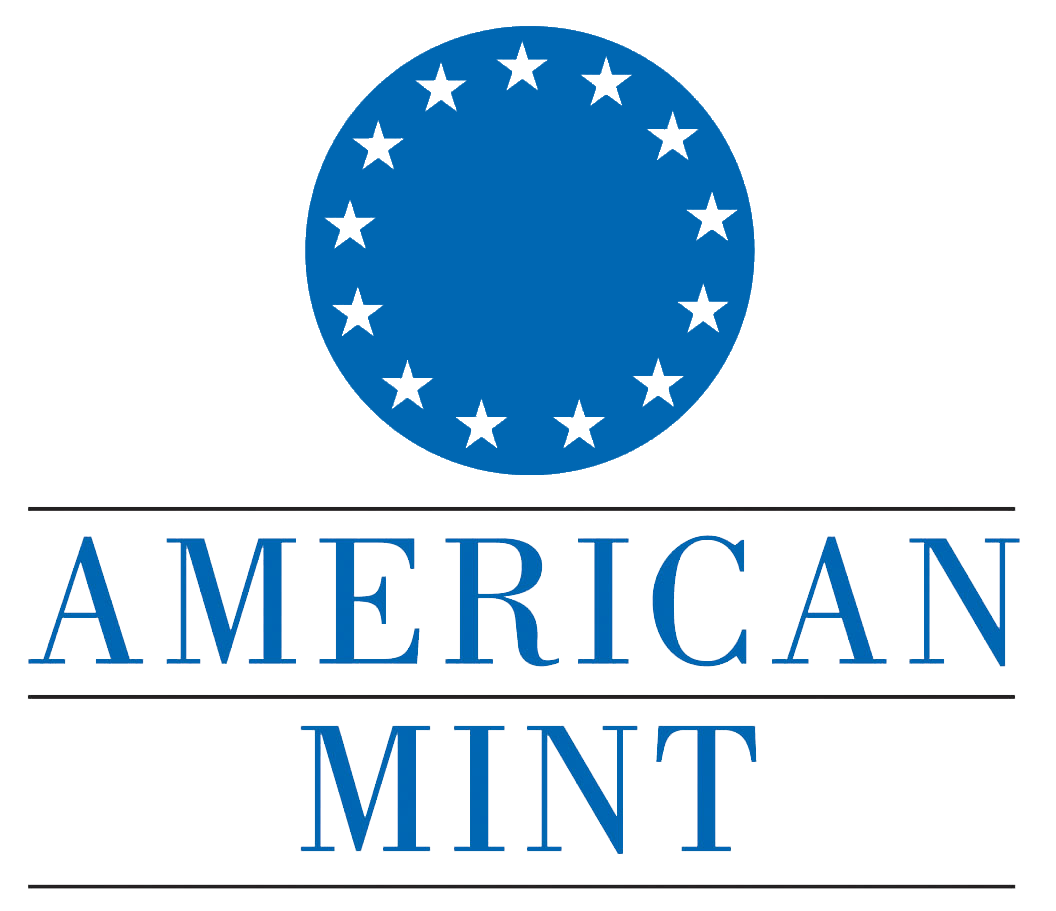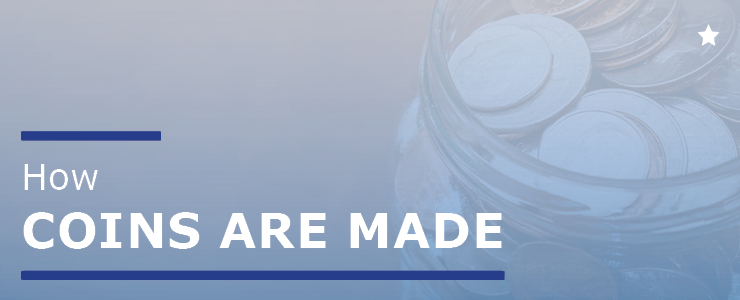
Pennies, nickels, dimes, quarters, and more — we interact with them on an almost daily basis. If you’re a coin collector, you spend a lot of time working with them, studying them, and researching them. If you aren’t a coin collector, you probably don’t spend much time thinking about them at all, beyond occasionally dropping them in that spare change jar on the shelf.
Despite how little we might think about coins, there’s a whole world of information to learn about them. We could talk about who chooses the designs on them, how they’ve evolved throughout history, or how one coin becomes more valuable and rare than another. Today, we want to spend a little bit of time talking about how a coin is made.
This topic is easy to overlook. Many people assume that a coin-collector will already know and that anyone who isn’t a coin collector won’t know or care to know. It's therefore easy for someone to enter the coin-collecting world without knowing this information, and they can move forward with the hobby while never learning along the way how coins are made.
That’s why today we hope to teach you how coins are made. Whether you’re learning these details for the first time or just looking for a refresher, we believe you’ll learn something new.
What Are Coins Made Of?
Before we get into the details of how a coin is physically created, let’s look at the different materials they're made of. Of course, it’s slightly different for every coin, which is plain to see on the surface level alone. Some coins have a gold color, others have a silver tint, and of course, pennies have their unique copper color.
But there’s more going on beneath the surface of a coin that’s less apparent. Out of all the coins that we commonly use today, none are made out of a 100 percent pure metal without additional additives. Mixing is not a new practice, either. Even in the past, it was common to mix metals together to form coins.
The following is a brief glance at the metals used to make each of the coins still in use in the U.S. today.
1. Pennies
When it was first released in 1793, the penny was made from pure copper. Beginning in 1793 and lasting until 1837, this composition changed to 95 percent copper and five percent combination zinc and tin. This specific alloy of metals is what we call bronze.
Next, the composition changed to 88 percent copper and 12 percent nickel, giving the penny an odd, white tint. In 1864, the composition returned to bronze and stayed that way until World War II. In an attempt to support the war effort, pennies were made out of zinc-coated steel for the entire duration of 1943.
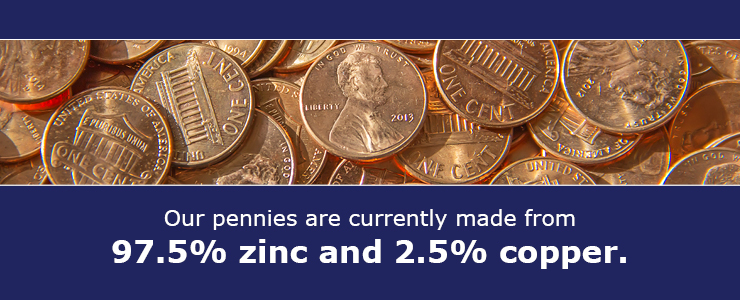
The composition was altered again in 1962, when all traces of tin were removed from the penny. The alloy changed one final time in 1982, when it arrived at the composition still used today. Currently, our pennies are made from 97.5 percent zinc and 2.5 percent copper. This combination means that, although pennies still appear copper, they are almost entirely zinc, albeit with a copper coating.
2. Nickels
Nickels do not have quite as long a history as pennies do, as they originated in the mid-1800s. Their composition has also not changed in any notable ways since the first creation. Nickels were and still are comprised of 75 percent copper and 25 percent nickel.
The irony is that the penny, which looks like it’s entirely made of copper, contains barely any of this metal. On the other hand, the nickel — whose name suggests it might be made entirely of nickel — contains only one-quarter nickel and is otherwise wholly copper. It all goes to show that appearances in the coin world are not always what they seem.
3. Dimes
When they were first created, dimes were made of almost 90 percent silver, while the remaining 10 percent was copper. In 1965, however, all silver content was removed from the dime. The composition changed altogether, and the coin that resulted from these changes is still the same one that we use today.
Dimes today are made from an outer layer that consists of different types of metal bonded together. This bonding process is also known as cladding, and it holds the metals together. The outer layer is comprised of 75 percent copper and 25 percent nickel. The inside of the coin is a pure copper core. Despite outward appearances to the contrary, there is currently no silver content in our dimes.
4. Quarters
Like the dime, the quarter was originally comprised of almost entirely silver. This composition all changed in the 1960s, when legislation ordered the removal of silver from coins such as dimes and quarters due to shortages and rising prices of precious metals. After this, quarters moved to what is still their current composition.
Interestingly enough, quarters are now made in the same way as dimes. They're formed from an outer layer of copper and nickel cladded together. The interior of the coin is a pure copper core.
How Is a Coin Made?
To describe how coins are made, we’ll break the process down into several smaller steps.
1. Preparing the Metal
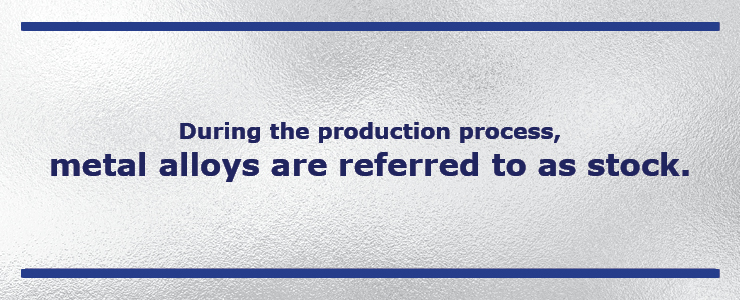
The first step in coin production actually takes place outside any mint. Metal vendors work in factories to prepare the alloys for use by the mints. Here, workers add the correct percentages of metals together to create the specific alloys needed for each type of coin. During the production process, these metal alloys are referred to as stock.
The alloys are then melted down in furnaces before they’re poured out into rectangular molds. As the stock cools in these molds, it’s rolled out under pressure into sheets of the appropriate levels of thickness. The stock hardens during this stage, necessitating a process known as annealing. Annealing consists of repetitive periods of heating and cooling designed to soften the stock and bring it to the correct consistency.
After these steps are finished, the sheets are cut into strips of about 13 inches by 1,500 feet. These strips are rolled into long coils that are then sold off to mints, where they’ll be made into coins.
2. Engraving and Molding the Master Hub
If an entirely new coin is being commissioned, the mint will begin by employing sculptors to sketch out ideas and possibilities. This process continues until a sculptor produces a sketch that is approved by all relevant parties. After this time, the sculptor creates a clay model of the approved sketch that might be as much as three times larger than the coin will be.
Next, plaster will be poured over the model, creating a reverse model. The words of the chosen inscription are carved into the plastic, backward. The sculptor may repeat this entire process multiple times if necessary and will continue until the model is perfect.
The next step is creating a rubber mold. To achieve this mold, workers will pour epoxy into the reverse plaster model. The finished epoxy mold is then mounted onto a transfer engraver. This tool includes a stylus that will trace the mold and a ratio bar that will copy the design while reducing it to the appropriate ration and size for the coin.
The result of this process is a correctly scaled replica known as the master hub. The sculptor will look the newly completed master hub over and remove imperfections. If it is satisfactory, the process can move forward.
3. Crafting the Working Dies
For the next step, a metal that’s been appropriately heat-treated is used. This metal is put under a lathe, where it’s then polished and smoothed out until it becomes a perfectly measured blank die. The master hub, which is the replica of the design that was made earlier, is then pressed into the blank die.
Once the impression of the master hub has been made on the blank die, it becomes known as the master die. This master die is then used to create many secondary working hubs and working dies. After their work is done, the master die and master hub are carefully put into storage in case they’re needed later.
4. Making the Blanks
Remember the metal coils of specially prepared metal alloys that we discussed earlier? This stage is where those come into play. The coils are carefully fed into a blanking press, which is a machine that punches out uniform disks in the exact size and shape of the new coins to be minted.
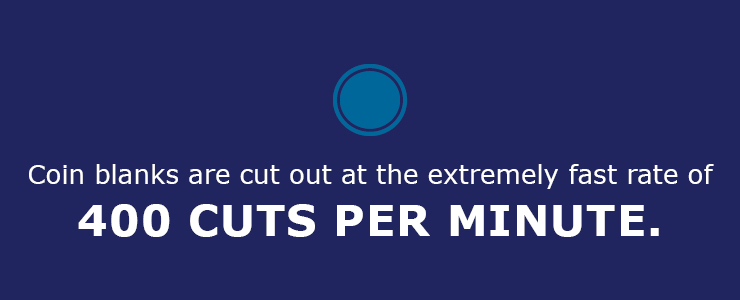
These disks are called blanks. They’re cut out at the extremely fast rate of approximately 400 cuts per minute. Any metal scraps left over at the end of the process will be shredded and discarded.
Once they’ve been cut out, the blanks go through another annealing process, which is the same process the metal went through during its initial processing. The blanks are repeatedly heated and cooled until they arrived at the right consistency for molding and shaping. Various lubricants are also used during this time so that the coins are appropriately oxidized and stained.
When this part is finished, the blanks are put into revolving tubs filled with a highly acidic pickling agent, which helps burnish the newly created blanks.
Finally, the blanks are sorted out. Since it would take too long to sort them by hand, a riddler is used. The riddler is a metal sheet full of holes in the exact size and shape of the new coins. If a coin doesn’t fit perfectly through the holes, it's thrown out. Using this method, mints can easily identify the misshapen blanks and discard them before they make it any further in the process.
5. Creating the Coins
Now that the blanks have been punched out, carefully treated and sorted, the next step is to turn them into coins. During this step, a conveyor belt carries all the perfect blanks that passed inspection to the coining press, where they’ll be stamped with all the correct inscriptions and designs.
A steel collar is placed into the press, where the working dies that were created earlier are loaded and ready. Highly pressured air is forced into the machine, pushing the blank coin into the steel collar. At the same moment, the dies are pushed into the blank on both sides. The impact of this contact creates deep impressions on both sides of the blank. If the coin is supposed to have ridged edges, the steel collar will also be equipped with ridges to form these edges.
Once the impression has been formed, the press releases the coin and sends it out on a conveyor belt toward the inspection line.
6. Finishing the Process
The workers operating the press will carefully examine each batch of brand-new coins. They will look over the coins with a magnifying glass, checking for anything that might look wrong. Then, the coins will go through another riddler that will sort out any that became dented or bent during the minting process.
The coins that pass this inspection then move through an automatic counting machine that sorts out a specified number at a time and drops them into large bags. The bags are then sewn shut, placed on pallets and hauled into storage vaults by forklifts.
7. Additional Quality Control Measures
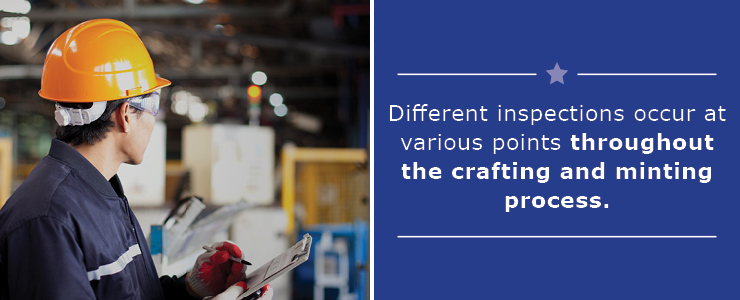
Different inspections occur at various points throughout the crafting and minting process. Workers will examine the metal alloys using x-ray technology or a chemical process to test that the metal composition is exactly as it should be. They will measure the diameter and check the surface condition of the blanks as well as regularly weigh the new coins.
All of these measures are put in place to ensure that the quality of these new coins remains consistent, no matter how many batches are produced. In performing these quality control checks, mints are doing the most they can to ensure that every coin that enters circulation is as consistent and perfect as is humanly possible.
Browse Our Selection of Coins Today
While we know a bit more about the long and complicated process that goes into creating an entirely new coin, we have a greater appreciation for the coins around us. Whether it’s a simple penny or dime that we received as change at the grocery store or a rare and valuable coin that we’ve just added to our collection, we’re better able to understand all the work that went into making it.
If you’re interested in starting your own coin collection, we’d like to invite you to browse our wide selection of coins here at American Mint. Even if you already have an impressive coin collection, we think you might find something you like here as well. Our coins are all high-quality, and they're sold at reasonable prices that you can afford. In addition, if you shop online, you'll find that many of our products are currently eligible for an online discount.
Browse our entire selection online today. You never know what you might find. If you have any questions at all, we’d be happy to answer them. Contact us online, or give us a call at 1-877-807-MINT.
